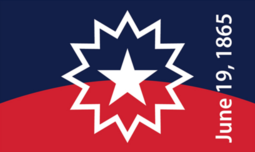Each and all of us, created in the image of God, are one body – our church, our community, our world. As Jesus teaches us, we love, we share fellowship, we value and defend the dignity of all God's children. FMC's Equity & Social Justice Committee invites you to pursue your personal spiritual development to gain understanding of your role in social justice. We do this by providing opportunities for learning and spiritual growth, to acknowledge a true shared history, and to heal and to build a just and equitable community.
Juneteenth: “What’s it All About?”
from the Equity & Social Justice Committee
Juneteenth is the oldest nationally celebrated commemoration of the ending of slavery in the United States. Although, our country celebrates on July 4 th the signing of the Declaration of Independence in 1776 that declared “all men are created equal” and have the right “life, Liberty, and the pursuit of happiness,” the 600,000 enslaved African Americans at that time were not included.
By the beginning of the Civil War in 1861, there were almost 4 million slaves in this country. Nearly a third of the people living in slaveholding states were enslaved. During the Civil War, President Abraham Lincoln signed the Emancipation Proclamation, declaring that more than 3 million slaves living in rebellious Confederate states to be free. There were slaves in border states or in states already under Northern control that the emancipation law did not include. However, the proclamation raised hope and added moral force that strengthened the Union cause. Some of the slaveowners in those rebel southern states started to move to other areas of the South
where they could continue to own their slaves.
After the Civil War, Texas was one of the states that did not recognize Lincoln’s Executive order. Many of the over 200,000 Texan slaves didn’t realize they were supposed to be freed as they could not read or write. On June 19, 1865, a few months after the end of the Civil War, General Gordon Granger rode into Galveston with 2000 Union troops to enforce the Emancipation Proclamation and the freedom of slaves. That is when the first Juneteenth Day Celebration occurred. A group of approximately 1000 freed families celebrated in a peaceful church-oriented event to give thanks to God for their freedom.
Simply declaring slaves to be free in Texas did not mean slaves were free “to go.” Gen. Granger encouraged slaves to remain where they were and work for pay. But, of course, droves of freed slaves left Texas to find family members and more welcoming accommodations in northern states.
Slave owners were not happy about losing their “human property.” Many former slaves were beaten, lynched, or murdered as they tried to leave. Police stations were formed to control newly freed African Americans. Segregation laws arose rapidly in the south and freed slaves were unable to congregate in public places or parks. In the 1870’s, former enslaved persons pooled around $800 to purchase 10 acres of land in Houston, Texas naming it “Emancipation Park.” Until the 1950’s that park was the only public park and swimming pool in that part of Texas that was open to African Americans. Until recently, many of the Juneteenth Day Celebrations were small gatherings.

The Juneteenth Flag was developed by Ben Haith two centuries after Betsy Ross sewed the first American flag. The white star in the center represents the Lone Star State of Texas. The bursting around the star is a nova, or a new star, representing a new beginning for African Americans in Galveston and throughout the land. The curve through the flag represents a new horizon – opportunities and promise. The red, white, and blue colors are a reminder that slaves and their descendants are Americans and represent the continuous commitment of people in the United States to do better – to live up to the American ideal of liberty and justice for all.
Since 2021, June 19th - Juneteenth Day is a federal holiday in this country to honor the culture and achievements of African Americans. One of the prominent traditions in today’s celebrations is the serving of red punch symbolizing the shed blood of enslaved Black people. Other traditions include street fairs with music, dance, food, and vendors. Some people choose to celebrate in more intimate gatherings with friends and neighbors.
The Perkins Center for the Arts has been hosting a Juneteenth Celebration. Our church continues to support this annual event.
How can we as Christians support freedom and equity for all.
- Support black and minority owned businesses.
- “Be intentional with speaking up and out against racism.”
- Learn all you can, and then “be intentional in understanding the plight of individuals that look different than you.” Our church library has a number of books that may be helpful to you.
from interview with Baptist Pastor Larry Weathers:
https://churchmarketinguniversity.com/juneteenth-what-churches-need-to-know/
Methodism in Black and White
Rev. Patti Walz offers a presentation entitled, “Methodism in Black and White.” Included are photos of Philadelphia’s Historic St. George’s United Methodist Church and Mother Bethel African Methodist Episcopal Church, and an overview of the difficult history of union and division.
